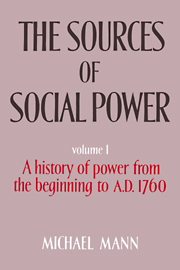Book contents
- Frontmatter
- Contents
- Preface
- 1 Societies as organized power networks
- 2 The end of general social evolution: how prehistoric peoples evaded power
- 3 The emergence of stratification, states, and multi-power-actor civilization in Mesopotamia
- 4 A comparative analysis of the emergence of stratification, states, and multi-power-actor civilizations
- 5 The first empires of domination: the dialectics of compulsory cooperation
- 6 “Indo-Europeans” and iron: expanding, diversified power networks
- 7 Phoenicians and Greeks: decentralized multi-power-actor civilizations
- 8 Revitalized empires of domination: Assyria and Persia
- 9 The Roman territorial empire
- 10 Ideology transcendent: the Christian ecumene
- 11 A comparative excursus into the world religions: Confucianism, Islam, and (especially) Hindu caste
- 12 The European dynamic: I. The intensive phase, A.D. 800–1155
- 13 The European dynamic: II. The rise of coordinating states, 1155–1477
- 14 The European dynamic: III. International capitalism and organic national states, 1477–1760
- 15 European conclusions: explaining European dynamism – capitalism, Christendom, and states
- 16 Patterns of world-historical development in agrarian societies
- Index
6 - “Indo-Europeans” and iron: expanding, diversified power networks
Published online by Cambridge University Press: 26 December 2009
- Frontmatter
- Contents
- Preface
- 1 Societies as organized power networks
- 2 The end of general social evolution: how prehistoric peoples evaded power
- 3 The emergence of stratification, states, and multi-power-actor civilization in Mesopotamia
- 4 A comparative analysis of the emergence of stratification, states, and multi-power-actor civilizations
- 5 The first empires of domination: the dialectics of compulsory cooperation
- 6 “Indo-Europeans” and iron: expanding, diversified power networks
- 7 Phoenicians and Greeks: decentralized multi-power-actor civilizations
- 8 Revitalized empires of domination: Assyria and Persia
- 9 The Roman territorial empire
- 10 Ideology transcendent: the Christian ecumene
- 11 A comparative excursus into the world religions: Confucianism, Islam, and (especially) Hindu caste
- 12 The European dynamic: I. The intensive phase, A.D. 800–1155
- 13 The European dynamic: II. The rise of coordinating states, 1155–1477
- 14 The European dynamic: III. International capitalism and organic national states, 1477–1760
- 15 European conclusions: explaining European dynamism – capitalism, Christendom, and states
- 16 Patterns of world-historical development in agrarian societies
- Index
Summary
During the second and early first millennia b.c., the Middle Eastern empires of domination were shaken by two immense challenges, which appeared external and yet which they had stimulated. Most empires did not survive – some vanished, and others were incorporated as units into others' dominions – and those that did survive were profoundly changed by the challenge into “world empires,” self-styled. The two challenges were the military dominance of charioteers between about 1800 and 1400 b.c. and the spread of iron weapons and tools from about 1200 to 800 b.c. These revolutions had three similarities: They emanated from the north, from no settled peoples, and from no literate peoples. These facts create difficulties for our analysis, for we need to shift to areas whose precise location is unknown and to peoples who at first left few remains and records. In these circumstances it is difficult to avoid the mistake passed to us by the empires themselves, that these events constituted “sudden eruptions” of barbarism and catastrophe.
But the real story is not one of the clash of two separate societies. In this period the unitary model of society bears little relationship to reality. What happened is explicable in terms of (1) the initial stimulus given by the Near East to a steadily widening geographical area and to the diverse power networks contained there and (2) a subsequent growth in the extent of overlapping, intersecting power interactions within this area.
- Type
- Chapter
- Information
- The Sources of Social Power , pp. 179 - 189Publisher: Cambridge University PressPrint publication year: 1986



